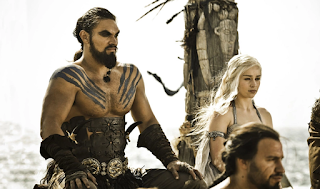The Ring and the Fall
In the letter to
his friend, J.R.R. Tolkien discussed much of the processes he used and the
thoughts he put into creating The Silmarillion.
Within this discussion, he mentioned the fall of man and how allegory,
especially concerning that fall, was necessary in a creation story. While he
regarded the fall to be that of the elves and did not feel that the fall of man
came into the story at all, the rings which became central in the chronologically
later books can be a physical representation of the Fall as well as of sins.
The
ring, as we have discussed in class, can be representative of various things
including power, colonialism, and greed. When looking more generally at the
rings, they come to represent what is bad. This is in large part due to the
fact that Sauron was the one who tempted everyone into making and wearing the
too powerful rings. Nine of these rings went to man, seven to the dwarves,
three to the elves, and the most powerful, of course, went to Sauron who made
it behind everyone’s backs.
While the Tolkien focused
on the fall of elves in The Silmarillion,
the creation of the rings brings men more into the forefront as they succumb
to the power. Everyone who accepted the rings could be viewed as partaking in
the fall, but none are punished as much as humans. The elves, who had already
fallen when Melkor tempted them, are not particularly punished and the dwarves
who take rings out of greed are not really heard about again with their presumptuous
deaths. The nine men who took the rings were Kings originally who were tempted
by power and abnormally long age. Soon after, their greed and lust for power
transformed them from men to the Nazgul or ringwraiths who are neither alive
nor dead and continuously search for the ring for Sauron. As mortality is the
gift of men, they were transformed for their sin and for trying to go against
what is in a way divine law by attempting to live longer and can be considered
a kind of fall. Although this only happens to these nine particular men, it
becomes like a mark on humanity and shows how easily man can sin – something which
is elaborated on even more with the story of Isildur.
In battle, Sauron
is temporarily destroyed after his ring is cut off his hand by Isildur after
Sauron kills his father. Isildur takes the ring and rather than destroying it
in, he decides to keep the ring as it can become a sort of heirloom, or source
of pride and remembrance as well as possibly power. He is soon after killed by
orcs and the ring is lost. His descendants and house are then cursed as his
heirs from his inability to destroy the ring so that Aragorn must conceal his
identity for a time out of fear that he would be endangered if Sauron and
others found out who he was. As a result of Isildur’s failure to destroy the
ring, perhaps from a source of pride as well as greed, he commits a kind of sin
which leads to the fall of his whole lineage.
The One ring
serves as many different devices throughout the series and can symbolize
various things. It’s main purpose, however, is that of temptation which leads
all, but especially men, to sin, stray, and fall as it awakens feelings of lust
for power and greed.


The idea of the fall of men is very interesting, it shows how us how in one way or another there must be a weak race in which falls because of greed or lust. When it comes to the humans in accordance to the rings they are the first to fall under the greed and lust of power. Power that they themselves don’t poses but the other races do. The idea that they fall easily under sin is very interesting because it puts men under the idea of being weak and pretty much an easy target when it come to manipulation. Is Tolkien maybe pointing out a reality in his creation when it comes to humans?
ReplyDeleteInteresting point on the rings representing greed, lust, and power. In addition, I believe the rings have numerous biblical ties, that may have been intentional by Tolkien. Tolkien’s mythology is very similar to the Christian mythology with the rings, but I never realized that the rings could have been related to the fall. I like your idea on how the rings are a central idea that can be a physical representation of the Fall and sins. The fall can be seen as the original sin, and the rings are seen as representing sins because everyone has trouble staying away from it no matter how hard they try.
ReplyDelete